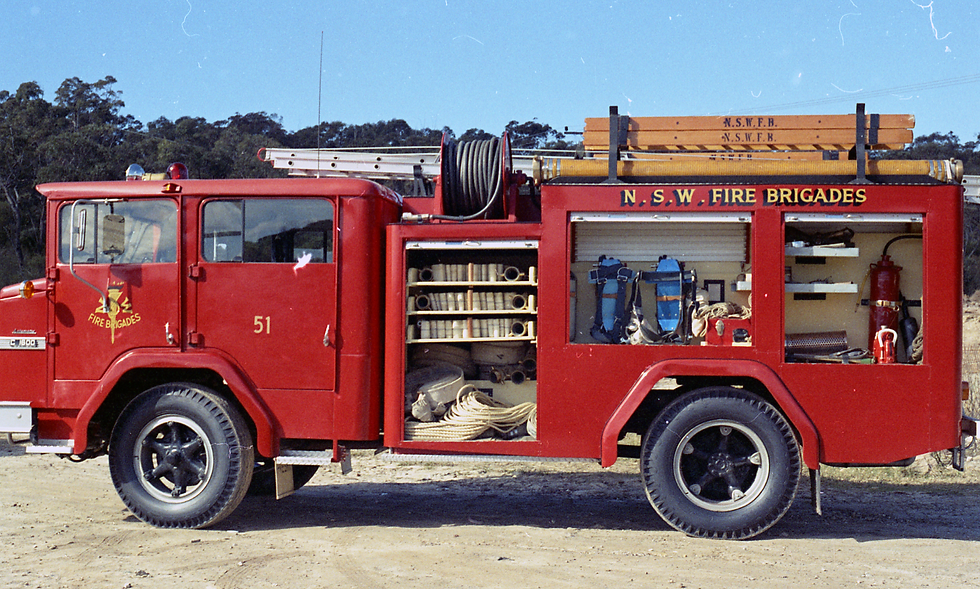In the lead up to the Museum’s ‘International’-themed Heritage Day this Sunday, we thought it an opportune time to take a look at an International vehicle. Get to know a little more about the International ACCO C1600 and then drop by this Sunday to see it in person!
In the early 1970s, International pumpers were introduced to the New South Wales Fire Brigades (NSWFB; now Fire & Rescue New South Wales) fleet. The International Harvester Company, who originally dabbled in the manufacturing of industrial agriculture machinery out of Chicago in the United States of America, had expanded their range of vehicles to industrial trucks and military-use vehicles (you can read more about the International Harvester Company on our blog here). By the 1960s, International had established warehouses and begun manufacturing vehicles in Australia after recognising that the vehicle requirements in Australia differed somewhat to their American counterparts, and therefore offered an opportunity for new approaches to design and production.

This expansion to Australian shores allowed for NSWFB to replace their aging Dennis F2s and Commers, which were invaluable in the 1950s to the Brigade, but now fast falling behind in new technology. The International C1600 Pumpers were selected as replacement vehicles and procured from Australian owned Presha Engineering in Melbourne, Victoria. At the time, Presha Engineering was a division of the Fire Fighting Enterprises and therefore a convenient and logical choice.
The International C1600 appliances were fitted with a V8 petrol engine and automatic transmission, as well as a Godiva Mk6 aluminium centrifugal pump, rated at 500gpm (38Lt/sec at 830kPa). The appliances also included a large 1820 litre water first aid tank, which allowed the appliance to be used in off-road situations to attend bush fires. Interestingly, the largest water tank previously fitted to a NSWFB vehicle was a 200 gallon (910 litre tank), so the C1600 already showed great promise. Another popular feature of the C1600 was the dual cab configuration. These double cabs were reportedly very popular in the Brigade as they allowed for firefighters to converse with one another on the way to and from a call, which in turn engendered a strong sense of camaraderie. The NSWFB ordered 17 of these appliances and these were the first complete mobiles to be wholly designed and assembled in Australia to Board of Fire Commissioners specifications. This meant that these vehicles boasted a level of uniqueness and customisation, and were considered a “new breed of fire engines” (Fire News, Vol 09. 1972) for the NSWFB. Each appliance cost $17,000 (the equivalent of about $185,000 today), with the first of 15 Internationals installed at Mortdale in October 1972. The other vehicles were progressively installed across Sydney stations between 1972 and 1973. The appliance in the Museum’s collection is ME 468, making it the 11th unit in this group.

This popular International appliance had a number of progressive models: from the 1610A, 1710A, B and C, the 1700 and the 1800 series. In each series, the motor size remained the same, however the pumps being fitted were adapted over time and reached up to 750gpm (57Lt/sec at 830kPa). Another change through the series was the locker arrangements, with the flaked hose being stored at the rear. A number of the later models were also fitted out as foam motors, having the first aid tank reduced to a 900 litre foam tank. These units were not readily discernible, though some had ‘FOAM’ labelled on the side, whilst others had a large red container behind the cab.
On another note, did you know that the International C1600 ME 468 in the Museum’s collection has some history from around western Sydney? Interestingly, this connection was with the University of Western Sydney. In 1995, the University of Western Sydney received this 1973 International C1600 Pumper to replace the university's 1961 Ford Thames model. The NSWFB Deputy Commissioner at the time, Ross Freeman, presented the appliance to the university and the volunteer University Brigade, which was made up of both staff and students. The University Brigade Captain, Bob Johnson, had received training from NSWFB and had responded to 16 incidents across the campus over the previous 12 months at the time of receiving the vehicle. These incidents included grass fires, alight garbage bins and a chemical spill within the University grounds.

This particular vehicle entered service in 1973 at Northmead Fire Station, and was then transferred to Blackheath Fire Station in 1981, before serving as a part of the Bushfire Unit in 1992. It was then loaned to the Hawkesbury Agricultural College (run by the University of Western Sydney) before being withdrawn from service in 2000.
Do you want to go beyond the blog? Come and see this vehicle in-person! A selection of International vehicles (and a few others) from the Museum’s collection will be on display at the Museum’s upcoming Heritage Day. Come down to the Museum on Sunday February 13th from 9am-2pm to take a look.
For information on the upcoming Heritage Day click here:
https://www.museumoffire.net/heritage-display-days
- Story by Natasha, Heritage Manager

Comments